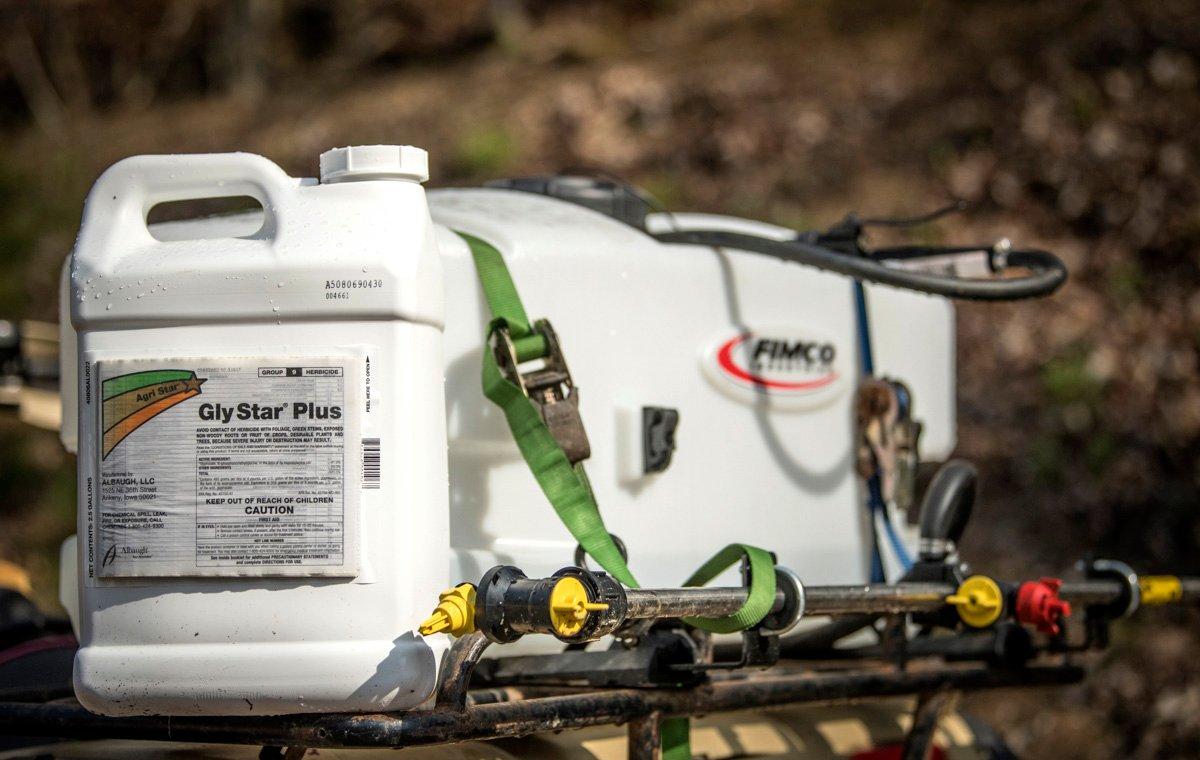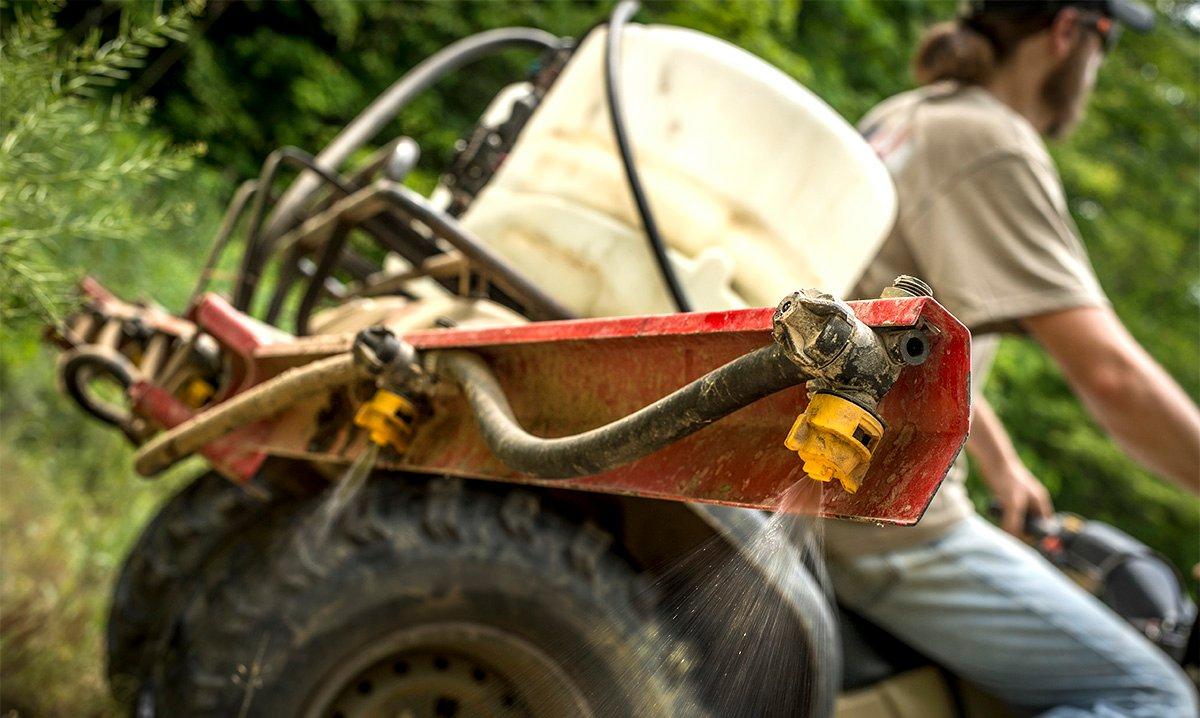You don't need a chemistry degree to spray herbicides, but a basic understanding is paramount for pretty plots
Weeds are the worst. While disking and mowing helps keep them at bay, spraying herbicide is generally the final maneuver for winning the war on weeds. Clover, alfalfa, trefoil and other food plot crops do well with consistent cutting throughout the growing season, but plants like soybeans, peas, lablab, sorghum and other warm-season species do not. While spraying is important regardless of cutting tolerance, it's crucial where mowing isn't possible.
Learn the Herbicide Families
There are two general categories of herbicides: pre- and post-emergent chemicals. Pre-emergent herbicides prevent seeds from germinating in the first place. This type of spray does not stop plants that have already sprouted and grown at least a few inches tall. While commonly used by farmers, pre-emergent herbicides aren't as applicable for food plotters since weeds and food plot seeds typically grow in unison. Plus, such herbicides generally remain active in the soil much longer, so extra planning is required.
Then there are post-emergent options, which are more commonly used by hunting land managers. These come in three basic options: non-selective, broadleaf-selective and grass-selective herbicides.
Non-selective sprays kill everything. All living plants will die when they come into contact with one. This family of herbicides is best suited for site-clearing and spot spraying. Glyphosate is the most common option.
Broadleaf-selective herbicides (such as 2,4-D, Pursuit, Raptor, etc.) kill broadleaf plants, but not grasses. These are great for terminating milkweed, morning glory, pigweed, ragweed, thistles and other pesky broadleaf weeds.
Grass-selective chemicals (including Arrest Max, Select, Volunteer, Poast, etc.) kill grasses but do not harm broadleaf plants. A few common nuisances in this department include Bahiagrass, Bermudagrass, crabgrass, Johnsongrass, fescue, ryegrass, stiltgrass and many more.
Glyphosate
Ever used Roundup? That's glyphosate, and it's likely used more than any other non-selective herbicide. It's great for clearing food plots of weeds prior to breaking ground. Spray when vegetation is 5 to 6 inches tall for the best results.
This is a popular post-emergence option among food plotters. In fact, it's used so much that some genetically-modified food plot seeds, such as certain soybeans and corn, come Roundup Ready, meaning they're resistant to the chemical. This allows farmers and food plotters to spray this herbicide even after the desired food plot species is established. Roundup Ready seeds — and name-brand Roundup — are both expensive. Luckily, there are generic alternatives to Roundup that are much cheaper, and they even come with surfactant (which helps the herbicide stick to the weeds) already mixed in.
For the best results, spray this systemic herbicide on food plots before breaking ground and while weeds are actively growing. Plants absorb the chemical and transfer it to the roots, effectively killing the entire thing. This chemical isn't active in the soil, though, so it unfortunately won't prevent future weeds from emerging, but neither will it hurt the food plot seed you put in the ground.
2,4-D and 2,4-DB
This is the broadleaf king slayer of herbicides. Land managers commonly use this to spray oat, sorghum, rye and wheat plots. Used correctly, it kills broadleaf plants - including clover - without damaging grass. This is a systemic chemical, so spray it when undesirable species are already present. That said, 2,4-D can remain active in the soil up to 30 days. Imazethapyr is similar in that it will kill certain broadleaf plants, but it can remain active in the soil up to 45 weeks after application - so it's only useful if you want to go full scorched-earth on a plot. Always read the label to determine how long sprays remain active.
Butyrac 200 (2,4-DB) is similar to the more common variety, but there are certain legumes that it will not kill. This makes it a better spray option depending on your goals. While it will kill brassicas, chicory, most forbs, and many other popular broadleaf species, there are some types of alfalfa, corn, certain cereal grains, clover and other perennial legumes that it will not kill.
Clethodim and Sethoxydim
Generally recognized as Arrest Max, Arrow, Select, and numerous other names, Clethodim is a selective, grass-specific herbicide. Grasses have strong root systems that compete with crops for moisture and nutrients, making them the most common problem in food plots. Clethodim is the most common chemical used to kill grass weeds in food plots, including undesirables like Bermuda and fescue. Just remember that you'll likely have to buy surfactant separately and mix it in.
The active ingredient in Clethodim is absorbed by the grass to kill it from within, so to speak. It's a great option for broadleaf plots - such as different brassicas, beans, clovers and peas - because it doesn't affect them. Don't spray corn, oats, sorghum or wheat with it, though, as these are part of the grass family.
Note that it can take 10 to 30 days to completely kill grass. Also, without proper application, you might experience some plot burn (i.e. wilted, yellowing leaves). But as long as you administer the proper dosage, non-target species will bounce back quickly.
Sethoxydim is another post-emergent active ingredient that's similar to Clethodim. It's commonly purchased as Poast, Poast Plus and Vantage. As a selective chemical, it only affects the plants listed on its tag and won't damage broadleaf plants. It's a systemic herbicide and doesn't remain active in the soil. This herbicide is used mostly to remove annual grasses in food plots. However, like Clethodim, it's a fairly slow killer, and often takes 10 to 12 days to fully kill unwanted grasses in plots.
Start Spraying
Still having a hard time choosing the correct spray? Read the label. Herbicide labels will list what plants the chemical will and will not kill. Then, read the directions thoroughly. Be sure to use the correct ratio of water and chemicals, and the right volume, to properly dose the acreage you're spraying. Take appropriate safety measures, too, including wearing safety glasses and long pants and sleeves.
Then, once all the equipment is in place, make some mist. Spray when weeds are established and growing, but still young - waiting until they're mature is less effective. Spray under optimal conditions: on cloudy days without wind and rain. And that's all it takes to keep undesirable weeds from snuffing out your lush, green plots.
Don't Miss: Best Tools for Low-Budget Food Plotters
Check out more stories, videos and educational how-to's on land management.












